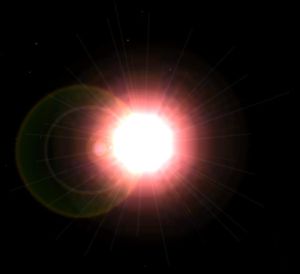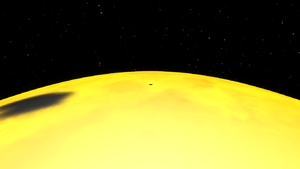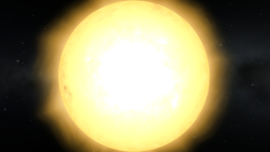Kerbol
| Kerbol | ||
| Kerbol as seen from orbit. | ||
| Star | ||
| Physical Characteristics | ||
| Equatorial radius | 261 600 000 m | |
| Equatorial circumference | 1 643 681 276 m | |
| Surface area | 8.5997404×1017 m2 | |
| Mass | 1.7565459×1028 kg | |
| Standard gravitational parameter | 1.1723328×1018 m3/s2 | |
| Density | 234.23818 kg/m3 | |
| Surface gravity | 17.1 m/s2 (1.747 g) | |
| Escape velocity | 94 672.01 m/s | |
| Sidereal rotation period | 432 000.00 s | |
| 20 d 0 h 0 m 0 s | ||
| Sidereal rotational velocity | 3 804.8 m/s | |
| Synchronous orbit | 1 508 045.29 km | |
| Sphere of influence | ∞ | |
| Atmospheric Characteristics | ||
| Atmosphere present | Yes | |
| Atmospheric pressure | 16.0000 kPa | |
| 0.157908 atm | ||
| Atmospheric height | 600 000 m | |
| 1.6×10-7 atm | ||
| Temperaturemin | 3741.80 °C 4014.95 K | |
| Temperaturemax | 9348.05 °C 9621.2 K | |
| Oxygen present | No | |
| Scientific multiplier | ||
| Surface | N/A | |
| Splashed | N/A | |
| Lower atmosphere | 1 | |
| Upper atmosphere | 1 | |
| Near space | 11 | |
| Outer space | 2 | |
| Recovery | 4 | |
Kerbol (officially called the Sun or the Star) is the parent star of the planetary system in KSP, popularly referred to as the Kerbol System. As of version 0.90.0, it has seven known children: the planets Moho, Eve, Kerbin, Duna and Jool and the two dwarf planets Dres and Eeloo.
“Kerbol” is a fan-made portmanteau of “Kerbal” and “Sol” — the Latin name for the real-life Sun. Before version 0.11, which introduced an object for KSP's parent star and an orbital Map view where it was explicitly named, it was an unnamed directional light source at infinite distance. Fans on the KSP forums invented and popularized the name.
Contents
In-game Description
| “ | The Sun is the most well known object in the daytime sky. Scientists have noted a particular burning sensation and potential loss of vision if it is stared at for long periods of time. This is especially important to keep in mind considering the effect shiny objects have on the average Kerbal. — Kerbal Astronomical Society |
” |
Orbiting Kerbol
Escaping the SOI of any other body will place an object in orbit around Kerbol. This will give a Science situation of being in space high over Kerbol until an altitude less than 1,000 Mm is reached. Low orbit can be reached by using a standard Hohmann transfer; from Kerbin's orbit this requires about 8 km/s of change-in-velocity (Δv). The more efficient way to reach low Kerbol orbit, at the expense of drastically increased flight time, is to use a bi-elliptical transfer. With a sufficiently-distant apoapsis, the required Δv to “sundive” from Kerbin orbit can be reduced to under 4 km/s.
At around 1,340 m above the surface, there is a sudden increase in temperature which rapidly causes overheating and destruction to parts and kerbonauts on EVA; this marks the closest sustained altitude possible for vessels or debris, though catastrophic dives to lower depths are possible. Orbits just above this boundary have an orbital period of 409.214 minutes and a speed of 66.945 km/s.
The sphere of influence (SOI) of Kerbol is infinite, making Kerbol inescapable. Thus, achieving gravitation-free flight is impossible. Once the apoapsis reaches a certain point, the game will report 68 years to reach it. This oddity occurs because times in KSP are limited to 232-1 seconds as a consequence of how numbers are handled. With a powerful enough ship, it is possible to get to the point where the info tab will display the craft's situation as “escaping” Kerbol. The end of the patched conics path plotted by the game can be reached, at which point the spacecraft begins drawing a course behind it. But the actual escape never occurs. Presumably, this state would continue indefinitely, as the time required to find out what would happen would take several years even at maximum time acceleration.
Landing
No known way of landing on Kerbol exists, even with all cheats enabled. The overheating effect quickly destroys parts before they can reach the surface. Interestingly, asteroids have a maximum temperature tolerance of 1038 so do not overheat even under these circumstances, but are instead destroyed at an altitude of -250 m, which shows in the end flight dialog as "crashed into the surface of the sun" or similar, rather than ever landing.
One can attempt to place edited parts on the surface, but they bounce erratically at a few hundred to a few thousand meters-per-second if they do not explode.
Temperature and Luminosity
Kerbol has a thin and hot atmosphere, or corona, that extends to a height of 600 km. The coronal temperature varies from 4,000 to 10,000 K. At its surface, the temperature is 5840 K and the pressure is 16 kPa. This temperature, along with the star’s yellow color, suggests that Kerbol is a Class G main-sequence star.
Based on its given size and temperature, Kerbol’s luminosity would be 56.7 yottawatts, however this is contradicted by other in-game physical parameters. The value of the solar constant at Kerbin is 1360 W/m2, which implies a solar luminosity of 3.16 yottawatts (0.008 Solar luminosities) and a surface temperature of 2840 K. These values are consistent with a Class M red dwarf.
Physical appearance
The equatorial radius of Kerbol is almost four times than that of Jupiter and 43.6 times larger than Jool's, the largest planet currently known. Kerbol has the yellow color of a Class G main-sequence star and its absolute bolometric magnitude is approximately +10. If close enough, one can see that the dark spots are indented.
The “corona” surrounding Kerbol is not the actual size of the sun as it appears. It will shrink and grow relative to the location of the viewpoint, just as the size of Kerbol does normally. However, it won't shrink past a certain point, and if the sun is viewed from a far enough point, the corona is still very visible. This is apparent when using camera or telescope mods that remove the corona and show Kerbol's true size, which is usually much smaller than the corona appears.
Past appearances

version 0.7.3 introduced the parent star of Kerbin as a slightly red-tinted directional light (with lots of lens flare) in the skybox at infinite distance, thus impossible to reach.

Reference Frames
| Time warp | Minimum Altitude |
|---|---|
| 1× | Any |
| 5× | 3 270 000 m |
| 10× | 3 270 000 m |
| 50× | 6 540 000 m |
| 100× | 13 080 000 m |
| 1 000× | 26 160 000 m |
| 10 000× | 52 320 000 m |
| 100 000× | 65 400 000 m |
All Kerbol orbits are in an inertial reference frame. In the old demo, getting close enough to experience the lower maximum time warps results in Deep Space Kraken attacks.
Trivia
- The name “Kerbol” was created by forum members and never appears in the game. Officially, the star is simply referred to as “the Sun," though the lead developer mentioned that its name could change once the need to differentiate it from other stars arises.
- It is possible "Kerbol" is a portmanteau of "kerbal" and "sol", the Latin name of the Sun.
- Kerbol has just under twice the surface gravity of Kerbin, thus only slightly more than Eve's.
Real-world comparison
While otherwise analogous to our own real-life Sun, Kerbol has 1/113th the mass and a 1/3rd its radius. Kerbol's other attributes can be used to derive the following statistics: it has a luminosity of approximately 3 yottawatts based on the solar constant at Kerbin; a defined surface temperature of 5840 K (that of a Class G star), but a temperature less than 3000 K based on its size and luminosity (that of a Class M star); the radius of a red dwarf; and the mass of a sub-brown dwarf. In reality, such a star cannot exist, as the minimum mass of a star is approximately 75 times the mass of Jupiter, a full power-of-ten greater than that of Kerbol. However, many astrophysical properties in KSP are effectively scaled down for gameplay.
Gallery
Up close the glow becomes evidently ennagonal.
Changes
- Art pass.
- Actual model added, new sprite/flare effect, size changed.
- Added solid surface (featureless invisible plateau ~4500–4700 km above nominal radius).
- Added Gravity, nominal radius of 65,400 km.
- Made it possible to reach Kerbol.
- Initial Release.





